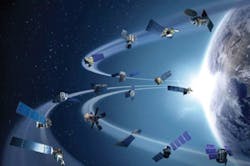Air Force asks industry for space communications to track and control multiple satellites
LOS ANGELES AFB, Calif. – U.S. Air Force space experts are reaching out to industry for communications technologies able to contact multiple satellites and other spacecraft simultaneously across several frequency bands to track and control a growing number of space vehicles in Earth orbit.
The Air Force is looking for new ways of controlling several different satellites at once to track and control a growing number of space vehicles in Earth orbit.
Officials of the Air Force Space and Missile Systems Center (SMC) at Los Angeles Air Force Base, Calif., have issued a request for information (FA8806RFI01) for the Multi-Band Multi-Mission Systems — Multi-Band Multi-Mission project.
A multi-band, multi-mission system could help the Air Force deal with the growing number of orbiting U.S. government satellites, and may augment or replace the current Air Force Satellite Control Network (AFSCN) and Launch and Test Range System (LTRS) infrastructure.
A future multi-band, multi-mission, space-control system could perform key telemetry, tracking, and control (TT&C) capabilities and radar functions, Air Force officials say.
Air Force space-control experts say they need to increase capacity, flexibility, interoperability, automation, and resiliency of space operations and spacelift because of the increasing number of satellites and space launches expected in the future.
A multi-band, multi-mission system should be able to contact several space vehicles simultaneously across several frequency bands and provide tracking radar to support the Air Force AFSCN and LTRS.
Air Force officials are asking industry for information on today’s available capabilities that companies could demonstrate with hardware in action. These capabilities should be able to meet the needs of the Multi-Band Multi-Mission Systems — Multi-Band Multi-Mission project now, or be modified to do so in the future.
Candidate technologies should be able to respond to a surge in demand for spacecraft tracking and control; support frequency bands such as VHF, UHF, C, L, S. K, Q, and X; communicate with spacecraft from low-Earth orbit to geosynchronous orbit, as well as launch and early orbit; be able to receive and distribute several telemetry and ranging downlinks and uplinks; operate on cloud-based computing; and monitor telemetry of several satellites simultaneously around the clock.
From companies that have suitable technologies, the Air Force wants to know how many simultaneous contacts, uplinks, and downlinks they can support; frequency bands supported; viewing and scan angles; data rates and modulation types; timelines to demonstrations; data rights and licensing needed; technology maturity levels; and available documentation.
Companies interested should e-mail responses no longer than 25 pages in Microsoft Word or .pdf formats to the Air Force’s Jeffrey Dedrick at [email protected]. E-mail questions or concerns to Jeffrey Dedrick at [email protected], Rachel Scollans at [email protected], or Capt. Alexander Bast at Alexander.Bast.[email protected].
More information is online at https://www.fbo.gov/spg/USAF/AFSC/SMCSMSC/FA8806RFI01/listing.html.

